National Refuges Working Boys' and Training Homes, London
Founded in 1843, The National Refuges for Homeless and Destitute Children (later known as the Shaftesbury Homes) had its origins in the Ragged School movement, then becoming increasingly involved in the provision of refuges and homes for destitute and homeless children.
In 1871, the Society launched a new venture, its Newsboys' Home. The home, at 80 Gray's Inn Road, aimed to offer modestly priced bed and board to boys who got their living on the city's streets. These included newsboys, who sold newspapers, cigar lights and other articles, and shoeblacks. The building, a former warehouse, was initially adapted to accommodate 50 boys. On the ground floor was an office, lavatory, kitchen and workshop. The first floor consisted of a single large living-room. The second floor included accommodation for the Superintendent and his wife, with space available for schoolroom or dormitory, and above, two dormitories, each capable of holding 60 or 70 beds. The cost of a night's lodging was 2d., and breakfast, dinner and supper were provided as cheaply as possible. Firewood chopping was organised, to enable the boys to earn some pocket money instead of spending their leisure at games such as pitch and toss. The front door was closed at 9p.m. and every effort was made to provide sufficient attraction indoors to compete with the lure of the streets.

Ad for Newsboys' Home, 80 Gray's Inn Road. © Peter Higginbotham
In 1873, after the lease on the Gray's Inn Road property expired, the Society opened a new establishment for the street sellers in a former public house at 20 Newton Street, Holborn. At the same time, the Girls' Refuge at 19 Broad Street, whose inmates had recently transferred to new premises at Sudbury Hall, was converted for use as a lodging house for boys, soon renamed the Working Boys' Home. Soon afterwards, the Newton Street house was converted into a similar establishment, taking boys who were making the transition into independent life from the Society's homes at Great Queen Street and then Bisley. In 1877, Newton Street was closed and its operation moved to19 Broad Street. The following year, when the Metropolitan Board of Works required the Broad Street site for constructing the new thoroughfare of Shaftesbury Avenue, this home was transferred again, to 36 Great Queen Street.
In 1886, the Society decided to bring together its London activities at a single location. A site was purchased on the now completed Shaftesbury Avenue and an architect was commissioned to design a new building. On 17th June, 1887, the Prince of Wales laid of the foundation stone of what was originally to be known as 'The Jubilee Memorial Home' in honour of Queen Victoria's Golden Jubilee. However, by the time the Countess of Jersey formally opened the completed building on May 15th, 1888, it had adopted the name Shaftesbury House, with the address of 164 Shaftesbury Avenue. The premises included accommodation for 100 destitute boys and 35 working boys, together with a club, institute and offices for the Society. The Working boys' department was renamed Fordham House in 1892 in memory of John Fordham, a long-serving Treasurer of the Society. Although it had its own entrance on Great White Lion Street (now Mercer Street), Fordham House adopted the address of 164A Shaftesbury Avenue.
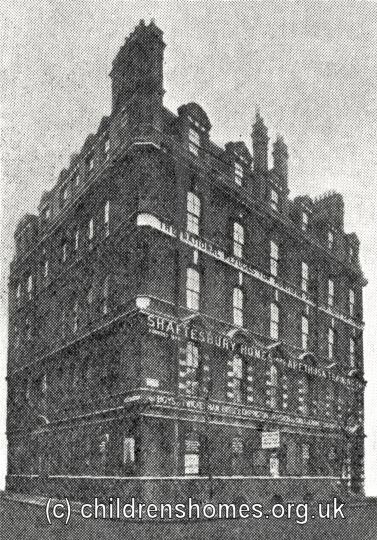
164 Shaftesbury Avenue. © Peter Higginbotham
In 1896, part of Shaftesbury House was adapted for use as a Technical School for the training of older boys in various trades. At the beginning of September, 1896, 26 boys who had passed the 5th Standard from the Twickenham and Bisley Homes, were placed in the Technical School for a two-year full-time apprenticeship. Of these, 14 were shoemakers and 12 tailors. During the last six months of their training, senior tailors worked under the direct supervision of the Assistant Tailor Master and gained experience in the making of ladies' costumes and best coat work. In the shoemaking department, the boys were closely monitored to record how much time they spent in the completion of each task and estimate what they would have earned in each case. Help with the technical training was given by the Merchant Taylors' Company and the Cordwainers' Company.

Fordham House tailors at work, early 1900s. © Peter Higginbotham
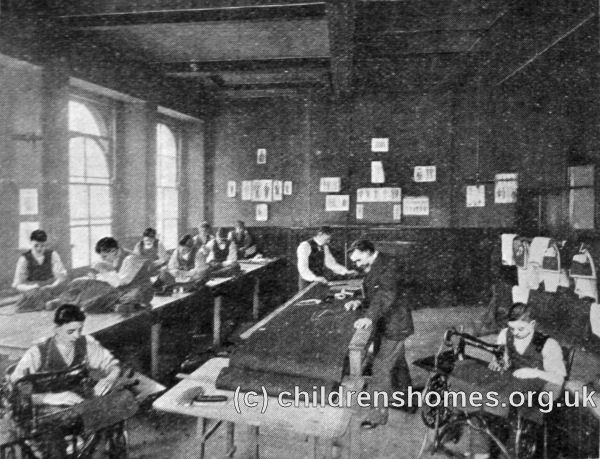
Fordham House tailors at work, early 1900s. © Peter Higginbotham
Sheomaking began with the cutting out of leather pieces from a large sheet.
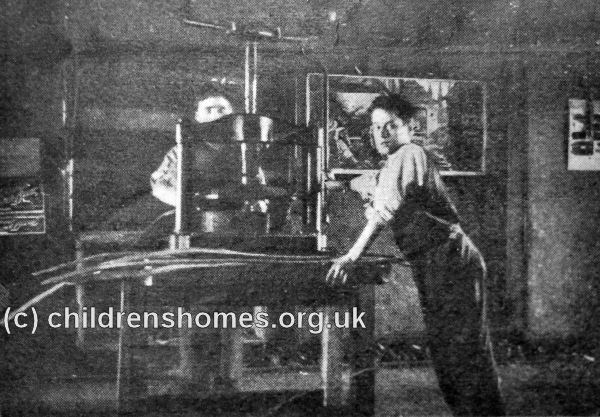
Fordham House shoemakers cutting up 'butt', early 1900s. © Peter Higginbotham
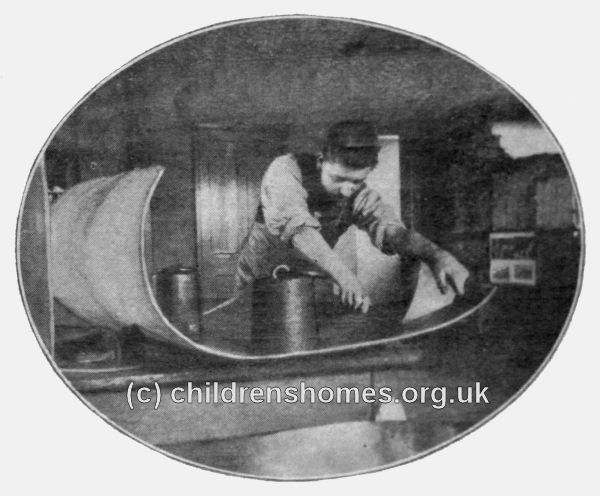
Fordham House shoemakers rough-stuff cutting on a press, early 1900s. © Peter Higginbotham

Fordham House shoemakers hand sewing, early 1900s. © Peter Higginbotham
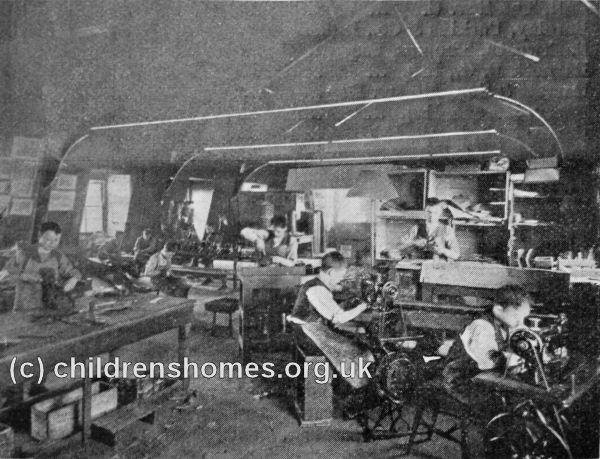
Fordham House bootmakers' shop, early 1900s. © Peter Higginbotham
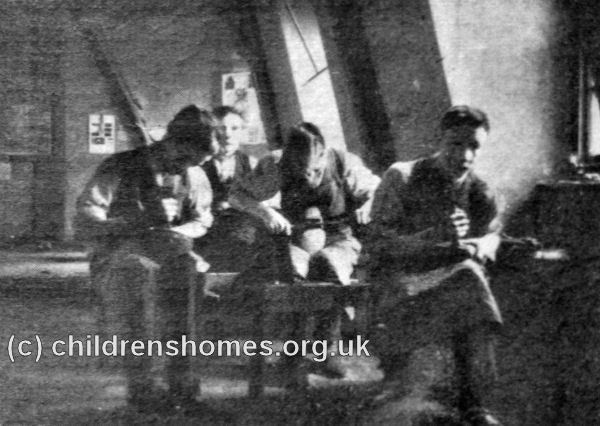
Fordham House shoemakers finishing department, early 1900s. © Peter Higginbotham
In 1900, the shoemakers were asked to make a special order of boots for King Kamswaga of Koki, Uganda. The unusually large size of his boots were illustrated by comparison to a typical pair of large ladies' boots.
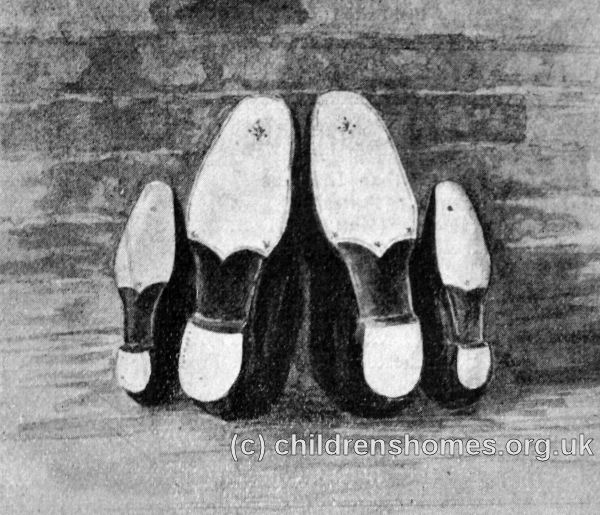
King Kamswaga's boots, 1900. © Peter Higginbotham
As well as the training facilities, Fordham House provided the boys with recreational and sporting facilities including a swimming bath and gymnasium.
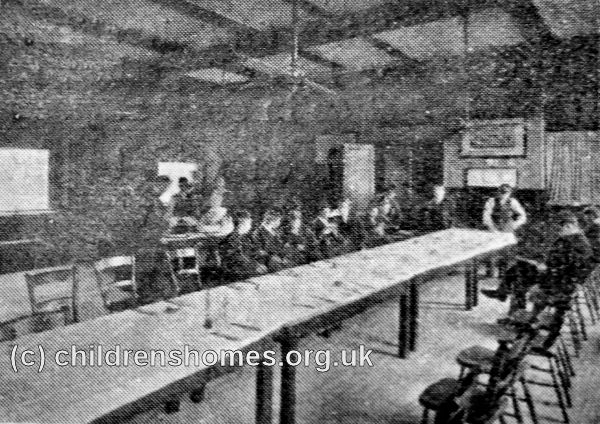
Fordham House dining room, early 1900s. © Peter Higginbotham
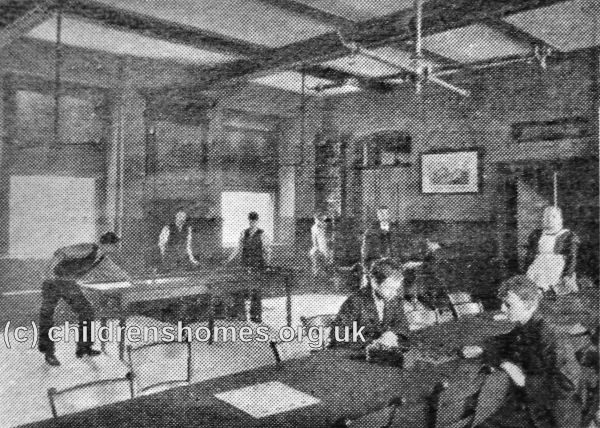
Fordham House recreation room, early 1900s. © Peter Higginbotham
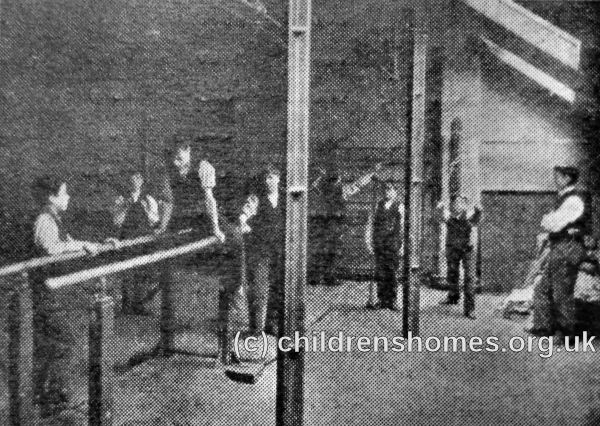
Fordham House gymnasium, early 1900s. © Peter Higginbotham
In November, 1906, a second Working Boys' Home was opened to accommodate boys who, after training in the Society's Homes, needed further help. Known as Southampton House, it was located at 17 Southampton Street, Fitzroy Square, initially with 17 boys in residence. Two years later, the Technical School and Working Boys' Home at Shaftesbury House were were merged into a single establishment. In 1912, Southampton House was doubled in size by taking over the adjacent property.
At the outbreak of war in 1914, the Superintendent of Southampton House, who was a former Royal Marine, was called up for service in drilling recruits. That, in addition to the large number of boys from the London Homes that had enlisted, led to the decision to close Southampton House and transfer the remaining boys to the Shaftesbury Avenue Home. For a time during the war, the London Home was used to provide a shelter for 12 Belgian refugee boys. The building was also used as an air raid shelter for people in the vicinity.
Boys at Fordham House were encouraged to attend evening classes at London County Council Institutes. Their keenness to become proficient enabled them to carry off many prizes and certificates. In 1915, one of the bootmakers became so proficient that he secured the appointment of Assistant Master in the Cordwainers' College.
At the start of the Second World War, Fordham House Hostel, as it was now known, had a blast wall erected and the ceiling of the basement shored up. An old locker room was turned into a dormitory with 42 bunks and beds for the male staff set up in an adjoining lobby. The swimming bath was converted into sleeping accommodation for the women.
In 1945, it was decided to close the Technical School. In November of that year, the hostel facilities moved to more spacious premises at Hampstead which retained the name of Fordham House Hostel. However, the steeply rising costs of the Society's operations — partly due to a post-war surge in the numbers of children being taken into care — meant that cuts had to be made. It was therefore decided in 1948 to close Fordham House for good.
Records
Note: many repositories impose a closure period of up to 100 years for records identifying individuals. Before travelling a long distance, always check that the records you want to consult will be available.
- The London Metropolitan Archives, 40 Northampton Road, London, EC1R 0HB now holds the archives of the Shaftesbury Homes and Arethusa Training Ship. More details in their online catalogue entry.
Bibliography
- Bailey, Marion Chance of a Lifetime - the Story of the Shaftesbury Homes and Arethusa (1996, Dianthus Publishing)
- Cuthbert, V Where Dreams Come True: A Record of 95 Years (1937, London: Shaftesbury Homes and "Arethusa" Training Ship)
- Higginbotham, Peter Children's Homes: A History of Institutional Care for Britain's Young (2017, Pen & Sword)
- Hodder, Edwin The Life and Work of the Seventh Earl of Shaftesbury, K.G. (1886, Cassell)
Links
Except where indicated, this page () © Peter Higginbotham. Contents may not be reproduced without permission.


